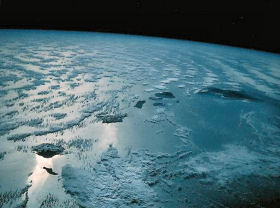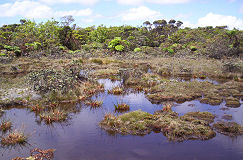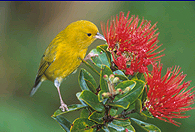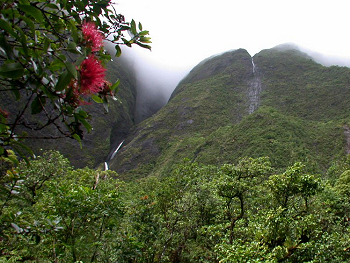
This page last revised 05 December 2007 -- S.M.Gon III
Introduction
Ecoregion
Conservation Targets
Viability
Goals
Portfolio
TNC Action Sites
Threats
Strategies
Acknowledgements
▫
Tables
Maps & Figures
CPT Database
Appendices
Glossary
Sources

 Arguably the world's wettest region, the Alaka'i plateau occupies central montane Kaua'i.
Arguably the world's wettest region, the Alaka'i plateau occupies central montane Kaua'i.
Kaua‘i boasts one of the richest forest bird concentrations in the ecoregion.
Appendix:
Kaua‘i Strategies
1998 ERP Strategic Summary
The 1998 ERP summarized strategies for the specific needs of each ofthe conservation areas defined by the large native landscapes ofeach major island. The directives established then have largely beenrealized and continue to evolve. In 1998, there was noestablished TNC program on Kaua‘i, and the 1998 ERP recommended thefollowing:
- Establish an active partnership with the State Divisionof Forestry and Wildlife (DOFAW), the U.S. Fish and Wildlife Service, Kaua‘i County, and atleast one of the four major private landowners (Alexander & Baldwin, Inc.,Gay & Robinson, Inc., Kamehameha Schools Bishop Estate, and JMBAmfac-Hawai‘i).
- Empower this partnership to identify and co-fund a set of projects to 1) test thefeasibility of preventing alien species damage in the most intact, remote partsof the site, 2) bring the best available stewardship to a set of smaller,high-diversity “hotspots” at lower elevations, and 3) engage the Kaua‘icommunity directly in the conservation of these places.
- TNC should hire a projectcoordinator to live on Kaua‘i, to work most closely with the Kaua‘i DOFAW teamand other local community contacts to develop the proposed partnership.
- Expand our funding commitment based on thequality/feasibility of the plans that the partnership develops. These plans may or may not include theacquisition of any land by TNC.
2007 Strategic Update
By the end of 2006, a growing Kaua‘i Program was established,realizing an on-island presence for TNC. A landscapewatershed management partnership, called the Kaua‘i WatershedAlliance (KWA) was formed, comprised of major landowners, and the Kaua‘i County Board of Water Supply.
TNC was contractedto draft a management planforthe partnership lands. This was completed in 2005 and includesgeospatially explicit plans for areas of ungulate and weed control, thetwo critical threats. As part of a "Go Deep" intensive managementeffort, priority weeds are the current focus of active intervention.
TNC has also been contracted by the KWA to be the primeimplementation contractor of its watershed management plan. Implementation has begun on the key elementsof the plan, which are very closely aligned with the management needsof conservation targets identified in the Kaua‘i Conservation Area of our ecoregionalportfolio, defined by a Conservation Action Plan (CAP) drafted for Kaua‘i.
In November 2007, TNC made a majorland management agreement on Kaua‘i,establishing the 7,050 acre Wainiha Preserve in cooperation with A&B, which complements our earlier management agreement with them at Kanaele Bog, a low-elevation, high-diversity "hotspot." We are exploring other selected conservation easements and agreements.

‘Ili‘ili‘ulastream drains from the core of the Kaua‘i Watershed down steepwindward cliffs into the Lowland Wet Ecological System.

